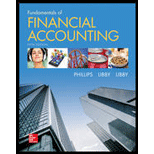
Fundamentals of Financial Accounting
5th Edition
ISBN: 9780078025914
Author: Fred Phillips Associate Professor, Robert Libby, Patricia Libby
Publisher: McGraw-Hill Education
expand_more
expand_more
format_list_bulleted
Question
Chapter 12, Problem 12.2SDC
1.
To determine
the two basic reporting approaches for the cash flows from operating activities used by Company L and to identify whether Incorporation HD is using the same reporting approaches for the cash flows from operating activities.
2.
To determine
The amount of cash received from issuance of long-term debt during the year ended January 31, 2014 by Company L.
3.
To determine
To explain: The amount of money spent by Company L during the year ended January 31, 2014 and to list the two largest
Expert Solution & Answer
Want to see the full answer?
Check out a sample textbook solution
Students have asked these similar questions
Can you help me solve this general accounting question using valid accounting techniques?
Can you solve this general accounting question with accurate accounting calculations?
Can you provide a detailed solution to this financial accounting problem using proper principles?
Chapter 12 Solutions
Fundamentals of Financial Accounting
Ch. 12 - Compare the purposes of the income statement, the...Ch. 12 - Prob. 2QCh. 12 - Prob. 3QCh. 12 - What are the major categories of business...Ch. 12 - Prob. 5QCh. 12 - Describe the types of items used to compute cash...Ch. 12 - Under the indirect method, depreciation expense is...Ch. 12 - Prob. 8QCh. 12 - Explain why a 50,000 increase in inventory during...Ch. 12 - Prob. 10Q
Ch. 12 - As a junior analyst, you are evaluating the...Ch. 12 - Prob. 12QCh. 12 - Prob. 13QCh. 12 - Prob. 14QCh. 12 - (Supplement 12A) How is the sale of equipment...Ch. 12 - Prob. 1MCCh. 12 - Prob. 2MCCh. 12 - Prob. 3MCCh. 12 - Prob. 4MCCh. 12 - Which of the following would not appear in the...Ch. 12 - Prob. 6MCCh. 12 - Prob. 7MCCh. 12 - Prob. 8MCCh. 12 - The total change in cash as shown near the bottom...Ch. 12 - Prob. 10MCCh. 12 - Prob. 12.1MECh. 12 - Matching Items Reported to Cash Flow Statement...Ch. 12 - Determining the Effects of Account Changes on Cash...Ch. 12 - Computing Cash Flows from Operating Activities...Ch. 12 - Prob. 12.5MECh. 12 - Computing Cash Flows from Investing Activities...Ch. 12 - Computing Cash Flows from Financing Activities...Ch. 12 - Computing Cash Flows Under IFRS Using the data...Ch. 12 - Prob. 12.9MECh. 12 - Interpreting Cash Flows from Operating, Investing,...Ch. 12 - Matching Items Reported to Cash Flow Statement...Ch. 12 - Computing Cash Flows from Operating Activities...Ch. 12 - Prob. 12.13MECh. 12 - Matching items Reported to Cash Flow Statement...Ch. 12 - Prob. 12.2ECh. 12 - Prob. 12.3ECh. 12 - Prob. 12.4ECh. 12 - Prob. 12.5ECh. 12 - Prob. 12.6ECh. 12 - Prob. 12.7ECh. 12 - Prob. 12.8ECh. 12 - Reporting and Interpreting Cash Flows from...Ch. 12 - Prob. 12.10ECh. 12 - Prob. 12.11ECh. 12 - Inferring Balance Sheet Changes from the Cash Flow...Ch. 12 - Prob. 12.13ECh. 12 - Prob. 12.14ECh. 12 - Prob. 12.15ECh. 12 - Prob. 12.16ECh. 12 - Prob. 12.17ECh. 12 - Prob. 12.18ECh. 12 - Prob. 12.19ECh. 12 - Prob. 12.20ECh. 12 - Prob. 12.21ECh. 12 - Prob. 12.22ECh. 12 - (Supplement 12B) Preparing a Statement of Cash...Ch. 12 - Determining Cash Flow Statement Effects of...Ch. 12 - Prob. 12.2CPCh. 12 - Preparing a Statement of Cash Flows (Indirect...Ch. 12 - Preparing and Interpreting a Statement of Cash...Ch. 12 - Prob. 12.5CPCh. 12 - Prob. 12.6CPCh. 12 - (Supplement 12A) Preparing and Interpreting a...Ch. 12 - Prob. 12.1PACh. 12 - Prob. 12.2PACh. 12 - Prob. 12.3PACh. 12 - Preparing and Interpreting a Statement of Cash...Ch. 12 - Computing Cash Flows from Operating Activities...Ch. 12 - Prob. 12.6PACh. 12 - (Supplement 12A) Preparing and Interpreting a...Ch. 12 - Prob. 12.1PBCh. 12 - Prob. 12.2PBCh. 12 - Prob. 12.3PBCh. 12 - Preparing and Interpreting a Statement of Cash...Ch. 12 - Prob. 12.5PBCh. 12 - Prob. 12.6PBCh. 12 - Prob. 12.1SDCCh. 12 - Prob. 12.2SDCCh. 12 - Prob. 12.6SDCCh. 12 - Prob. 12.7SDCCh. 12 - Prob. 12.8SDCCh. 12 - Prob. 12.9SDCCh. 12 - Prob. 12.1CC
Knowledge Booster
Similar questions
- Correct answer please general accountingarrow_forwardI need guidance with this general accounting problem using the right accounting principles.arrow_forwardFairview Industries recently purchased 128,000 units of raw material for $576,000. Four units of raw materials are budgeted for use in each finished good manufactured, with the raw material standard set at $24.00 for each completed product. Fairview manufactured 31,250 finished units during the period just ended and used 127,500 units of raw material. If management is concerned about the timely reporting of variances in an effort to improve cost control and bottom-line performance, what would the materials purchase price variance be? Need helparrow_forward
arrow_back_ios
SEE MORE QUESTIONS
arrow_forward_ios
Recommended textbooks for you
 Financial Accounting: The Impact on Decision Make...AccountingISBN:9781305654174Author:Gary A. Porter, Curtis L. NortonPublisher:Cengage LearningCentury 21 Accounting Multicolumn JournalAccountingISBN:9781337679503Author:GilbertsonPublisher:Cengage
Financial Accounting: The Impact on Decision Make...AccountingISBN:9781305654174Author:Gary A. Porter, Curtis L. NortonPublisher:Cengage LearningCentury 21 Accounting Multicolumn JournalAccountingISBN:9781337679503Author:GilbertsonPublisher:Cengage Cornerstones of Financial AccountingAccountingISBN:9781337690881Author:Jay Rich, Jeff JonesPublisher:Cengage Learning
Cornerstones of Financial AccountingAccountingISBN:9781337690881Author:Jay Rich, Jeff JonesPublisher:Cengage Learning Financial AccountingAccountingISBN:9781337272124Author:Carl Warren, James M. Reeve, Jonathan DuchacPublisher:Cengage Learning
Financial AccountingAccountingISBN:9781337272124Author:Carl Warren, James M. Reeve, Jonathan DuchacPublisher:Cengage Learning

Financial Accounting: The Impact on Decision Make...
Accounting
ISBN:9781305654174
Author:Gary A. Porter, Curtis L. Norton
Publisher:Cengage Learning

Century 21 Accounting Multicolumn Journal
Accounting
ISBN:9781337679503
Author:Gilbertson
Publisher:Cengage


Cornerstones of Financial Accounting
Accounting
ISBN:9781337690881
Author:Jay Rich, Jeff Jones
Publisher:Cengage Learning

Financial Accounting
Accounting
ISBN:9781337272124
Author:Carl Warren, James M. Reeve, Jonathan Duchac
Publisher:Cengage Learning
